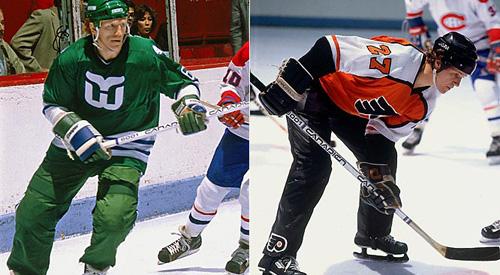
The Death of the Cooperall
Deep in the Carolina Hurricanes’ vast collection of promotional photos is a picture of a young Ron Francis. The future hall-of-famer, decked out in the colours of the Hartford Whalers, is seen jumping in the air after scoring a goal against the Philadelphia Flyers. What makes the photo unique isn’t the person or the play. Instead, the attention is directed to what Francis is wearing below his waist: full-length hockey pants.
They were called Cooperalls; named after Cooper, the company that manufactured them. Cooperalls contained padding from the waist to the ankles. This was much different than traditional hockey pants, which provided padding from the waist to the knees, and would be followed by shin pads covered with leggings.
At one time, Cooperalls were worn by all children who took part in organized hockey. They even made it to the NHL. Both the Whalers and Flyers incorporated them into their uniforms during the early ’80s. But Cooperalls were ineffective and would eventually be discontinued. They failed because of appearance and safety.
“Looking back on it, Cooperalls were such a marked difference from the original hockey pant/legging combination,” says Tyler McKinna of NHLDigest.com. “As with any distinct visual change, the fashion statement was difficult to get used to.”
As McKinna points out, a larger issue with Cooperalls was that they were very slippery and made falling more dangerous than usual. They simply provided less friction on the ice than the conventional equipment. Citing player safety, the NHL banned the use of full-length pants after the 1982-83 season. In retrospect, McKinna believes the NHL made the correct decision, but says there were a few players who publicly stated they felt more comfortable wearing Cooperalls.
[php snippet=1]
Although the Cooperall was considered to be a “fashion faux pas”, and its attempts to become a successful product turned futile, there still seems to be a small following of the full-length pants. A search on Facebook yields a few groups, all of which show support for the discontinued product. One group called “Cooperalls Forever” is dedicated to the “legacy of the Cooperall and those who wore them with pride!”
[php snippet=1]
Another group, “Bring back Cooperalls,” is “lobbying to bring back the best hockey equipment ever invented.” Of course, the statements on these group pages are half-joking. However, they do show that Cooperalls did make some sort of impact.
Will Cooperalls ever make a comeback? McKinna feels they could as long as they’re redesigned. He also notes that variations of the design are still used.
“Inline hockey has been successful using full-length pants and the designs are not bad at all from those manufacturers,” says McKinna. “I think a definite mindset shift would be required for ice hockey players/fans in order for long pants to make a sustainable comeback in mainstream hockey.”
Hockey equipment has vastly improved over the last 50 years. Technology has certainly played a major role, allowing players to be faster, safer and more effective. However, there are a few examples of inventions and improvements that didn’t have the desired result. Cooperalls can surely fall into that category. It was a piece of equipment that had good intentions, but unfortunately not much else.
[php snippet=1]

